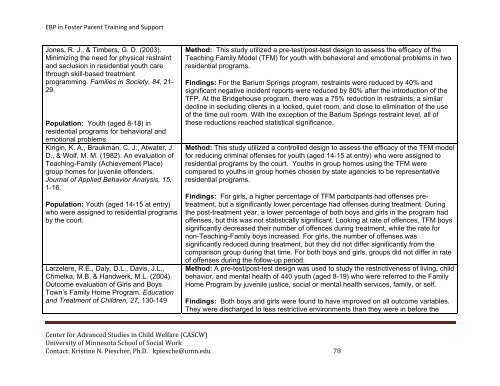Evidence-Based Practice in Foster Parent Training and Support ...
Evidence-Based Practice in Foster Parent Training and Support ...
Evidence-Based Practice in Foster Parent Training and Support ...
You also want an ePaper? Increase the reach of your titles
YUMPU automatically turns print PDFs into web optimized ePapers that Google loves.
EBP <strong>in</strong> <strong>Foster</strong> <strong>Parent</strong> Tra<strong>in</strong><strong>in</strong>g <strong>and</strong> <strong>Support</strong>Jones, R. J., & Timbers, G. D. (2003).M<strong>in</strong>imiz<strong>in</strong>g the need for physical restra<strong>in</strong>t<strong>and</strong> seclusion <strong>in</strong> residential youth carethrough skill-based treatmentprogramm<strong>in</strong>g. Families <strong>in</strong> Society, 84, 21-29.Population: Youth (aged 8-18) <strong>in</strong>residential programs for behavioral <strong>and</strong>emotional problemsKirig<strong>in</strong>, K. A., Braukman, C. J., Atwater, J.D., & Wolf, M. M. (1982). An evaluation ofTeach<strong>in</strong>g-Family (Achievement Place)group homes for juvenile offenders.Journal of Applied Behavior Analysis, 15,1-16.Population: Youth (aged 14-15 at entry)who were assigned to residential programsby the court.Larzelere, R.E., Daly, D.L., Davis, J.L.,Chmelka, M.B. & H<strong>and</strong>werk, M.L. (2004).Outcome evaluation of Girls <strong>and</strong> BoysTown’s Family Home Program. Education<strong>and</strong> Treatment of Children, 27, 130-149Method: This study utilized a pre-test/post-test design to assess the efficacy of theTeach<strong>in</strong>g Family Model (TFM) for youth with behavioral <strong>and</strong> emotional problems <strong>in</strong> tworesidential programs.F<strong>in</strong>d<strong>in</strong>gs: For the Barium Spr<strong>in</strong>gs program, restra<strong>in</strong>ts were reduced by 40% <strong>and</strong>significant negative <strong>in</strong>cident reports were reduced by 80% after the <strong>in</strong>troduction of theTFP. At the Bridgehouse program, there was a 75% reduction <strong>in</strong> restra<strong>in</strong>ts, a similardecl<strong>in</strong>e <strong>in</strong> seclud<strong>in</strong>g clients <strong>in</strong> a locked, quiet room, <strong>and</strong> close to elim<strong>in</strong>ation of the useof the time out room. With the exception of the Barium Spr<strong>in</strong>gs restra<strong>in</strong>t level, all ofthese reductions reached statistical significance.Method: This study utilized a controlled design to assess the efficacy of the TFM modelfor reduc<strong>in</strong>g crim<strong>in</strong>al offenses for youth (aged 14-15 at entry) who were assigned toresidential programs by the court. Youths <strong>in</strong> group homes us<strong>in</strong>g the TFM werecompared to youths <strong>in</strong> group homes chosen by state agencies to be representativeresidential programs.F<strong>in</strong>d<strong>in</strong>gs: For girls, a higher percentage of TFM participants had offenses pretreatment,but a significantly lower percentage had offenses dur<strong>in</strong>g treatment. Dur<strong>in</strong>gthe post-treatment year, a lower percentage of both boys <strong>and</strong> girls <strong>in</strong> the program hadoffenses, but this was not statistically significant. Look<strong>in</strong>g at rate of offences, TFM boyssignificantly decreased their number of offences dur<strong>in</strong>g treatment, while the rate fornon-Teach<strong>in</strong>g-Family boys <strong>in</strong>creased. For girls, the number of offenses wassignificantly reduced dur<strong>in</strong>g treatment, but they did not differ significantly from thecomparison group dur<strong>in</strong>g that time. For both boys <strong>and</strong> girls, groups did not differ <strong>in</strong> rateof offenses dur<strong>in</strong>g the follow-up period.Method: A pre-test/post-test design was used to study the restrictiveness of liv<strong>in</strong>g, childbehavior, <strong>and</strong> mental health of 440 youth (aged 8-19) who were referred to the FamilyHome Program by juvenile justice, social or mental health services, family, or self.F<strong>in</strong>d<strong>in</strong>gs: Both boys <strong>and</strong> girls were found to have improved on all outcome variables.They were discharged to less restrictive environments than they were <strong>in</strong> before theCenter for Advanced Studies <strong>in</strong> Child Welfare (CASCW)University of M<strong>in</strong>nesota School of Social WorkContact: Krist<strong>in</strong>e N. Piescher, Ph.D. kpiesche@umn.edu 78
















